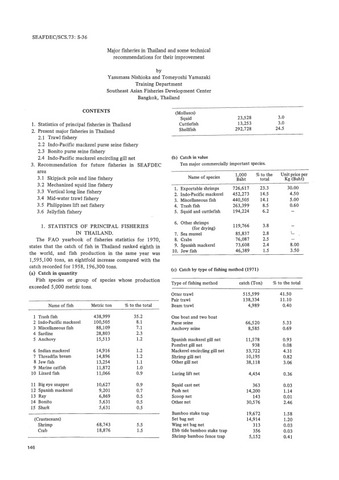Discards in Japanese Marine Capture Fisheries and their Estimation
Share
Abstract
By catch focused here is incidental catch to be discarded at sea and those utilised is dealt little. This is because, as widely stated, by catch is not necessarily a negative practice as there are many fisheries which are feasible with by catch in addition to the principal species. It is important to segregate by catch and discard issues. It may provoke unnecessary and unproductive contradiction, if by catch as a whole is dealt in the same line with discards. This report firstly overviews the structure of the fishing industry of Japan and its statistics in view of its sectors and landing. This aims at illustrating its basic characters and changes for the recent years. Secondly, the report summarises available information on discards from a sector to sector. It estimates, then, the amounts of discards by individual sectors and, subsequently, the total discard by the Japanese marine capture fishery as a whole. The last part of the report discusses improvement of methodology in discard researches. In this report, only publicised data were utilised for discard estimation with exceptions of those recorded by the author or the author's group. Discard ratios were either directly adopted or secondarily evaluated from those records.
Suggested Citation
Matsuoka, T. (1997). Discards in Japanese marine capture fisheries and their estimation. In Proceeding of the Regional Workshop on Responsible Fishing, Bangkok, Thailand, 24-27 June 1997 (pp. 218-241). Samut Prakarn, Thailand: Training Department, Southeast Asian Fisheries Development Center.
Subject
Related items
Showing items related by title, author, creator and subject.
-
Status of Fishing Conditions in Cambodia
Sour, Kim; Vuthy, Ros (Training Department, Southeast Asian Fisheries Development Center, 1997)Fisheries in plays a very important role in Cambodia’s national economic development. Total fish catch production in 1996 was 104 310 tones, about which 60% was contributed by inland capture fisheries, 30% by marine capture ... -
Major fisheries in Thailand and some technical recommendations for their improvement
Nishioka, Yasumasa; Yamazaki, Tomeyoshi (Japan International Cooperation Agency, 1977)Presented in this paper is the development of fisheries industry in Thailand. The data on the production of the principal fisheries species and major fishing methods are also presented. Also included are the recommendations ... -
Fisheries Management Policy in Malaysia: Issues on Responsible Fishing
Yassin, Abdul Hamid Bin (Training Department, Southeast Asian Fisheries Development Center, 1997)The legal and institutional policies on the management of the marine fisheries industry in Malaysia are presented in the paper. Specifically, management issues and problems that affect the industry, such as, overfishing, ...





